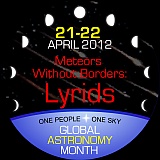April 21-22, 2012
 Perhaps you've seen "shooting stars" before, but during GAM you can witness a meteor shower!
Perhaps you've seen "shooting stars" before, but during GAM you can witness a meteor shower!
The Lyrids meteor shower happens each year from about April 16 to 26 but the most are seen on April 22. Don't expect continuous meteors covering the sky but you'll still see a good display. A shower occurs when Earth goes through a swarm of material in space and the meteors appear to come from one point in the sky known as the radiant, in this case in the constellation of Lyra (giving the annual event its name). You'll see the most Lyrid meteors near the shower's peak on April 22 as Earth moves through the debris left behind by Comet C/1861 G1 Thatcher, a regular visitor to the inner solar system referred to as a periodic comet. The recorded history of the Lyrids is longer than any other, with records of observations going back 2600 years.
Lyrid meteors are usually around magnitude +2, which is bright enough to be visible from most cities, but you'll see more and enjoy them more if you leave the city for a dark place where the stars shine brighter. They often produce luminous trains of dust that can be observed for several seconds. Some Lyrids will be brighter, though, and the occassional "fireball" can cast shadows for a split second and leave behind glowing, smoky debris trails that last for minutes. Lyrid meteors disintegrate after hitting our atmosphere at a moderate speed of 29.8 miles per second.
During GAM we include a global Lyrids Watch when everyone is encouraged to observe the Lyrids and send in reports of what they saw. Observing reports like this are valuable scientific evidence that is gathered and analyzed by the International Meteor Organization. Submit your data to IMO; Visual Meteor Observation
Tweet your data! You can also share your data by Tweeting your postcode, your country (click here to find your country code) and, optionally, the meteor count along with the hashtag; #MeteorWatch (you are welcome to use GAM hastags as well - #GAM2012 #LyridsWatch)
The meteor data will appear in a map at MeteorWatch.org
Resources:
Lyrids 2012 details at IMO
Visual Meteor Observation information at IMO
Share your Meteor experience with us:
Share your LyridsWatch images of outreach or meteor-photography with us via GAM2012 Facebook or Flickr group or Tweet using above mentioned hashtags (@gam_awb). Don’t forget to register your events here.







